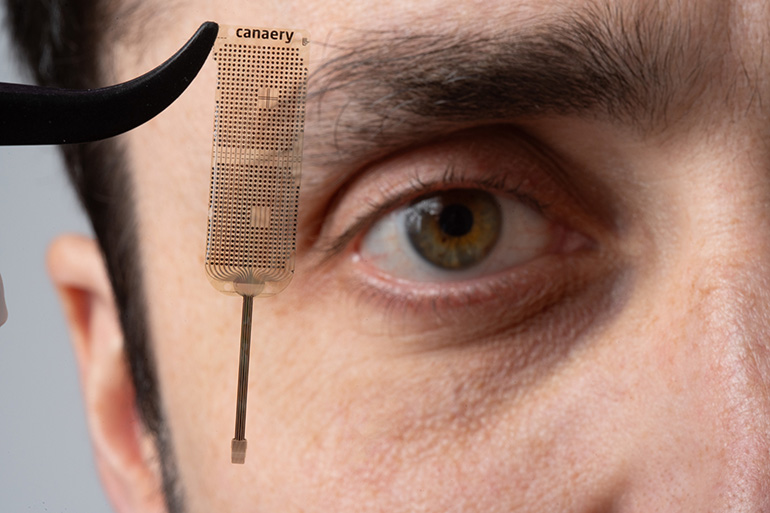Advanced Nose-Computer Interface Could Upgrade Rover's Drug Detection
Drug Enforcement TechPosted by AI on 2025-07-16 13:58:46 | Last Updated by AI on 2025-08-11 05:12:48
Share: Facebook | Twitter | Whatsapp | Linkedin Visits: 5

Law enforcement and security could be getting a boost with a new nose-computer interface that aims to improve drug detection. The interface, developed by the Lawrence Livermore National Laboratory (LLNL) and neurotechnology company Canaery, hopes to enhance the ability of scent-detection animals. The teams are focusing on improving the identification of contraband substances like narcotics. While current drug detection methods that rely on animals are effective, they are subject to handler influence, animal fatigue, and potential error. The interface aims to address these issues.
The advanced neural interface technology involves implanting an electronic device to read olfactory signals directly from a scent-detection animal's brain. These signals are then translated into a format that a computer can interpret. LLNL is contributing its expertise in fabricating flexible neural interfaces and biocompatible packaging, while Canaery is focusing on enabling human-readable identification of scents detected by animals. When developed, the nose-computer interface has the potential to transform drug detection. It could provide a more objective and reliable measure of a scent-detection animal's perception of narcotics, reducing the risk of false positives or negatives. It would also automate the analysis of olfactory signals, streamlining the drug detection process. This could open up new applications in border security, airport screening, and postal inspection.
However, there are ethical and practical concerns, including animal welfare issues around implanting electronic devices, ensuring a high degree of accuracy and reliability in identifying different narcotics under varying conditions, and cost-effectiveness. Further research is required regarding the ethics, regulations, and public perception of this technology before it can be widely utilized.
Overall, the nose-computer interface represents a significant advancement in scent-detection technology and has the potential to benefit law enforcement and security. While challenges remain, responsible and effective use of the technology could provide considerable benefits.
Travis Massey, a LLNL research engineer, said, "This is a new application that were interested in, and were excited about aligning our capabilities and Canaerys technology with the Labs larger national security mission."
Conclusion:
The development of this nose-computer interface has the potential to enhance our ability to detect drugs and improve law enforcement and security. While many challenges remain, responsible and effective use of this technology could be highly beneficial. The ethical concerns must be addressed and ensure that the technology is used beneficially. We look forward to following this innovative advancement in scent-detection technology.
Search
Categories
- Sports
- Business
- History
- Politics
- International
- Science & Technology
- Social Issues
- Disaster Management
- Current Affairs
- Education
- Startup Business
- Startup News
- Awards
- Community Services
- Fundraising Events
- Volunteer Services
- Health Initiatives
- Innovations and Initiatives
- In News
- dummybanners
- Awards
- Partners
- Products
- Press Releases
- News
- Fast Check
- South
- సినిమా
- Gallery
- Sunday Chronicle
- Hyderabad Chronicle
- లైఫ్ స్టైల్
- National
- క్రైం
- ట్రెండింగ్
- జాబ్స్
- అంతర్జాతీయo
- బిజినెస్
- రాజకీయం
- బిజినెస్
- సంపాదకీయం
- నవ్య
- చిత్ర జ్యోతి
- క్రీడలు
- జాతీయం
- తెలంగాణ
- తాజా వార్తలు
- మన పార్టీ
- మన నాయకత్వం
- మన విజయాలు
- డౌన్లోడ్స్
- మీడియా వనరులు
- కార్యకర్తలు
- North East Skill Center News
- Government Schemes
- Entrepreneurship Support
- Employment Opportunities
- Skill Training Programs
- Departments
- Investments
- Initiatives
- Resources
- Telangana IT Parks
- Events & Jobs
- Press Releases
- News
- Airport News
- Newtons Laws of Motion
- Karbonn in Business
- Investments in Karbonn
- Company quarterly sales
- Markets
- Auto News
- Industry
- Money
- Advertisements
- Stock target
- Company Updates
- Stock Market
- Company Sales
- Staffing and HR
- Constituency Assembly
- General News
- Srikalahasti Temple
- Bojjala Sudhir Reddy
- Technology & Innovation
- Sports
- Business
- Products
- Industries
- Services & Trainings
- Tools & Resources
- Technology Integration
- Drug Seizures & Arrests
- Telangana Narcotics
- Law & Enforcement
- Rehabilitation
- Nationwide Drug Policing
- Nigeria Seizures
- Global Operations
- Drug Awareness
- Drug Enforcement Tech
- NCB Drug Seizures
- Judicial Crackdown
- India's Surveillance Tools
- Cross-Border Links
- Women Safety
- Cyber Crimes
- Drug Abuse
- Traffic & Road Safety
- Community Connect
- Public Safety Alerts
- Citizen Assistance
- Nellore City News
- Politics & Administration
- Events & Festivals
- Agriculture & Rural
- Business & Economy
- Health & Wellness
Recent News
- Ex-RAW Officer Vikash Yadav's Sudden Arrest and Accusations
- Shillong Teer Results Today, August 11, 2025: Winning Numbers For All Teer Games
- Air India Executrix Delay Draws Flak From All Sides
- 'Mission Mausam': IMD Floats Global Tenders For 10 Weather-Monitoring Wind Profilers
- Noida Daycare Worker Arrested After She Assaults, Bites 15-Month-Old Child
- Congress Leader Anand Sharma Parts Ways With Foreign Affairs Post
- Air India Plane with Troubled MPs Diverted, and Airline Responds
- The Google Pixel 10 Series Readies For An Release, But Not Without A Few Twists